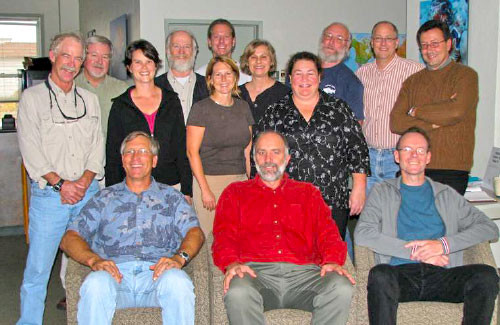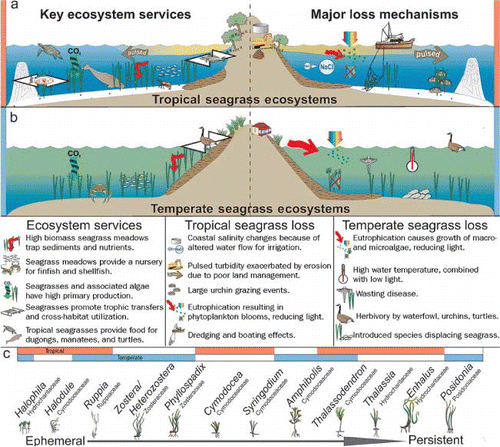Scientific synthesis at the University of Maryland Center for Environmental Science: Part 4--Moving beyond synthesis
Bill Dennison ·This post is part four of a four part series on scientific synthesis.
In some cases, scientific synthesis is not the end product, rather it can be the start of a science application effort. In a case study to demonstrate the use of scientific synthesis which led to a science application effort, I will recount our efforts regarding global seagrass trajectories. Beginning in 2005, Tim Carruthers, Bob Orth and I initiated a seagrass synthesis effort through the National Center for Ecological Analysis and Synthesis (NCEAS). When we created a NCEAS Seagrass Trajectories working group to develop and analyze global seagrass trajectories, we were encouraged to assemble a diverse group of scientists. This diversity of age, gender, geography and institutional affiliation proved extremely beneficial. The younger scientists made excellent contributions, and having diverse scientists enhanced our global analyses. Our team included Ainsley Calladine, Tim Carruthers, Carlos Duarte, Jim Fourqurean, Ken Heck, Randall Hughes, Gary Kendrick, Jud Kenworthy, Suzanne Olyarnik, Fred Short, Michelle Waycott, and Susan Williams.

Another feature of the NCEAS experience was one that we emulated in SESYNC--having the center in a small, accessible city with hotels, restaurants, coffee shops and pubs in close walking distances. This promotes an immersive experience and our group developed several social interactions that enhanced our group cohesion: brainstorming at a pizza parlor taking notes on paper plates, making a BYO tapas dinner in the hotel, and taking a mid-week field trip to break up the week. I also enjoyed meeting many of the spouses of the team who joined us in Santa Barbara, and in one case, Randall Hughes missed one of the working group meetings and brought along her baby at the next meeting to show is why she was unable to attend.

We began our synthesis process by taking stock of what we collectively knew about the status of seagrasses globally (Orth et al., 2006). We next assembled a global seagrass trajectories data set. We analyzed the data set that we had accumulated and wrote various synthesis papers which we published in a variety of scientific journals. The most important thing that we learned was that there was accelerating seagrass loss globally (Waycott et al., 2009). We also began to realize that seagrasses were not being considered as important as more charismatic ecosystems like tropical rain forests and coral reefs (Duarte et al., 2008). Thus, by the end of our NCEAS experience, we decided that we needed to address this 'charisma gap' of seagrass ecosystems. This got us thinking about how we have gone from 'charismatic megafauna' (e.g., pandas, whales, manatees) to 'charismatic ecosystems' (e.g., tropical rain forests and coral reefs), and that we need to expand the list of 'charismatic ecosystems' to include seagrasses.

One of our post synthesis actions was to put seagrasses onto the International Union for Conservation of Nature (IUCN) red list of threatened species (Short et al., 2011). We also investigated the use of high definition video to give people insights into the 'secret life' of seagrasses. Other efforts have included various seagrass fact sheets, brochures and videos.

As a result of our effort to make seagrasses more 'charismatic', IAN Press has 100 publications (books, newsletters, brochures, report cards, posters, reports and presentations) in which seagrasses are featured. There are 128 vector graphic symbols of different seagrasses in the IAN Symbol Library. There are 95 photos in the IAN Image Library as well. These web resources are freely available for use and many of our seagrass colleagues have been using the seagrass symbols and diagrams.
In a recent follow up synthesis effort with the Australian Centre for Ecological Analysis and Synthesis (ACEAS), we created a seagrass song and video: Seagrass Blue Carbon Blues in an attempt to expand our dissemination of seagrass issues. The song includes concepts of water quality influence on seagrasses, the need for seagrass conservation and the role of seagrasses as 'coastal canaries' of water quality.
The scientific synthesis that we conducted at NCEAS was crucial for the various applications that followed, but synthesis alone was not sufficient in our view. The use of scientific synthesis to create new knowledge combined with various applications of that new knowledge is what we consider the major achievement of our efforts. I hope that other synthesis groups consider expanding their efforts beyond the creation of new knowledge into applications of that knowledge.
References
Duarte CM, Dennison WC, Orth RJ, Carruthers TJB. 2008. The charisma of coastal ecosystems: Addressing the imbalance. Estuaries and Coasts 31: 233-238.
Orth RJ, Carruthers TJB, Dennison WC, Duarte CM, Fourqurean JW, Heck KLJ, Hughes AR, Kendrick GA, Kenworthy WJ, Olyarnik S, Short FT, Waycott M, Williams S. 2006. A global crisis for seagrass ecosystems. Bioscience 56: 987-996.
Short FT, Polidoro B, Livingstone SR, Carpenter KE, Bandeira S, Bujang JS, Calumpong HP, Carruthers TJB, Coles RG, Dennison WC, Erftemeijer PLA, Fortes MD, Freeman AS, Japtag TG, Kamal AHM, Kendrick GA, Kenworthy WJ, LaNafie, Nasution IM, Orth RJ, Prathep A, Sanciangco JC, van Tussenbroek B, Vergara SG, Waycott M, Zieman JC. 2011. Extinction risk assessment of the world's seagrass species. Biol Conservation 144: 1961-1971.
Waycott M, Duarte CM, Carruthers TJB, Orth RJ, Dennison WC, Olyarnik, S, Calladine A, Fourqurean JW, Heck KJL, Hughes AR, Kendrick GA, Kenworthy WJ, Short FT, Williams SL. 2009. Accelerating loss of seagrasses across the globe threatens coastal ecosystems. PNAS 106: 12377-12381.
About the author
Bill Dennison

Dr. Bill Dennison is a Professor of Marine Science and Interim President at the University of Maryland Center for Environmental Science (UMCES).